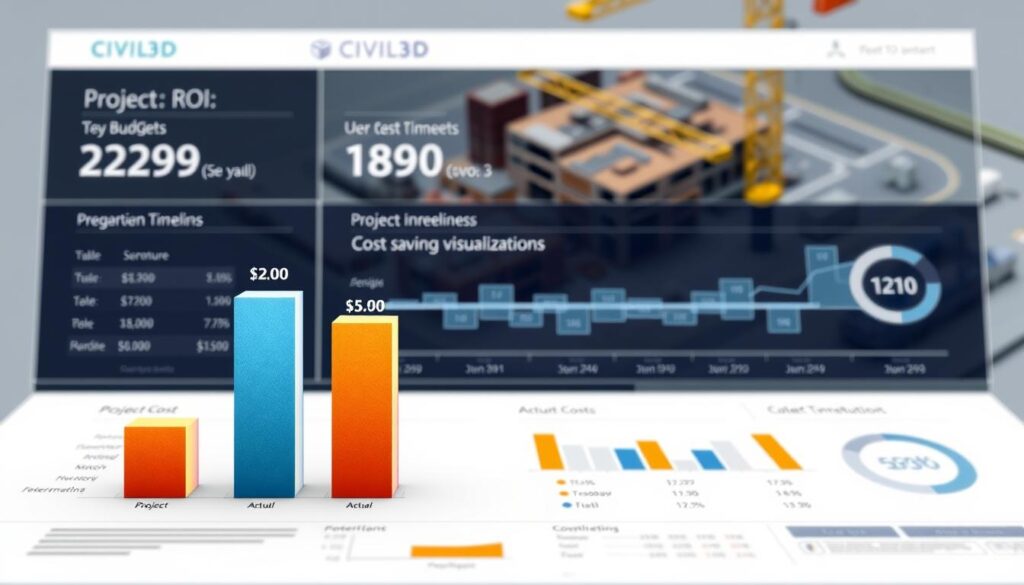Uncover the True Cost of civil 3d cost Software
Autodesk’s Civil3D is a top tool for civil projects. It offers a full design and documentation solution. Knowing its true cost is key for businesses.
The cost of Civil3D software is more than the first price. It also includes maintenance, upgrades, and training. These are vital for getting the most out of the software.
This article will give you a clear look at the Autodesk Civil3D pricing. It’s designed to help you decide wisely about using Civil3D.
What is Autodesk Civil3D and Who Uses It?
Autodesk Civil3D is a top software for civil projects. It has many design and documentation tools. It’s used by civil engineers and construction pros for its detailed project tools.
Core Functionality and Purpose
Civil3D helps civil engineers, surveyors, and designers. It’s great for making designs of roads, highways, and railways. It also helps with terrain analysis and creating construction plans.
The software makes design easier, more accurate, and helps teams work together better.
Primary Industries and Professionals
Civil3D is used in many fields, mainly by:
Engineering Firms
- : They use Civil3D for complex projects, thanks to its design and analysis tools.
Construction Companies
- : These firms count on Civil3D for detailed planning and execution, making sure designs are followed in construction.
Government Agencies
- : Governments use Civil3D for public projects, getting detailed designs and documents.
Knowing who uses Civil3D and what it does helps organizations see its value. It can improve project workflows and productivity.
Breaking Down the Civil3D Cost Structure
Understanding the cost of Autodesk Civil3D is key for businesses. It helps them make smart choices about software spending. The cost depends on the licensing model and the number of users.
Subscription vs. Perpetual Licensing
Autodesk offers Civil3D in two main ways: subscription and perpetual licensing. Subscription-based licensing lets you use the software for a fee that’s paid monthly or yearly. It also includes ongoing support and updates. On the other hand, perpetual licensing means you pay once for the software version you get. But, you’ll need to pay extra each year for support and updates.
Choosing between these models impacts your upfront and ongoing costs. Subscription models might offer more flexibility and the latest updates. But, perpetual licensing could save money over time for companies with steady needs.
Single-User vs. Multi-User Access
The cost of Civil3D also changes based on user numbers and access types. Single-user licenses are best for solo users or small teams. Multi-user licenses are better for big teams needing many users to access the software.
Network License Options
Autodesk has network license options for teams with many users. This lets you install the software on several computers but limits who can use it at once. It’s a good choice for teams where not everyone needs to use Civil3D at the same time.
Cloud-Based Access
Autodesk also offers cloud-based access. This lets users get to Civil3D from anywhere, on different devices. It’s great for teams working from home or in different places.
When looking at Civil3D’s cost, think about your team’s needs. Consider the number of users, access levels, and licensing preferences. This way, you can spend your money wisely and make sure Civil3D fits your business goals.
Current Pricing for Civil3D in 2023
Autodesk has updated its Civil3D pricing for 2023. Now, there are several subscription plans to fit various business needs. This change lets companies pick a plan that matches their budget and project needs.
Monthly Subscription Options
Autodesk offers a monthly Civil3D subscription for those who like flexibility. It’s perfect for companies with changing project needs or new to Civil3D. The monthly plan has a low start-up cost, helping with budget management.
Annual Subscription Plans
Annual plans are more cost-effective for long-term Civil3D users. By committing for a year, businesses save money compared to the monthly plan. This is great for companies with steady projects.
Multi-Year Commitment Discounts
Autodesk gives discounts for multi-year subscriptions. Locking in for 3 years or more can lead to big savings. This is ideal for big organizations or those with long-term infrastructure projects.
It’s important to understand the Civil3D subscription plans and their costs. Choosing the right plan helps businesses save money and have the tools they need for their projects.
Hardware and System Requirements
Knowing what hardware and system you need for Civil3D is key for the best performance. Autodesk gives clear specs to help users run the software smoothly.
Minimum vs. Recommended Specifications
Civil3D has both minimum and recommended system needs. The minimum requirements let the software run, but for the best experience, aim for the recommended specs. You’ll need a strong processor, enough RAM, and a graphics card that works well.
Upgrade Costs for Optimal Performance
Upgrading your hardware to the recommended specs can make Civil3D better. You might want to think about upgrading these parts:
Processor and RAM Considerations
A multi-core processor and enough RAM are vital for big Civil3D projects. Autodesk suggests at least 16 GB of RAM. But, for really big projects, 32 GB or more is often needed.
Graphics Card Requirements
A certified graphics card is key for Civil3D’s smooth running. Make sure your graphics card meets Autodesk’s needs to avoid problems with display and performance.
Training and Implementation Expenses
To get the most out of Civil3D, you need to think about the costs of training and setup. It’s not just about the initial cost of the software. You also need good training and a solid plan for using it.
Staff Training Programs and Resources
Autodesk has many training options for Civil3D. They offer online tutorials, classroom training, and customized training solutions for big groups. You can train your team in-house or hire experts for the job.
The price of training depends on how you choose to do it and how many people you need to train. For example, online tutorials might be cheaper for small groups. But, customized training for bigger teams could cost more but might be more effective.
Implementation Timeline and Resource Allocation
Creating a good plan for when to implement Civil3D is key. It helps avoid problems and makes the switch smoother. The time it takes can change a lot based on how big your team is, how complex your projects are, and how many resources you have.
In-house vs. Consultant-led Implementation
You can choose to set up Civil3D yourself or get help from outside experts. Doing it yourself might save money but could take longer. Getting consultants might cost more at first but can speed up the process and make sure you’re using it right.
| Implementation Approach | Cost | Timeline | Expertise |
| In-house | Lower upfront cost | Potentially longer | Variable, based on existing staff expertise |
| Consultant-led | Higher upfront cost | Faster deployment | High, consultants bring specialized knowledge |
Whether to do it yourself or get consultants depends on what you need, how much you can spend, and how fast you want to get started.
Hidden Costs of Civil3D Ownership
Buying Civil3D isn’t just about the upfront cost. There are hidden expenses to consider. Knowing these costs helps businesses plan better and get the most value from their investment.
Maintenance and Support Fees
Maintenance and support fees are a big part of owning Civil3D. These fees, a percentage of the software’s price, give you updates and support. For Civil3D, this can be 15% to 20% of the annual fee.
For example, if the annual fee is $2,500, you could pay $375 to $500 a year for support.
Upgrade Costs Over Time
Upgrading Civil3D to newer versions also comes with costs. Being on the latest version can improve performance and add new features. However, it means you’ll need to train your staff on the new tools.
The cost of upgrading varies. It’s important to include this in your long-term budget.
Productivity Loss During Transition
Switching to new software or upgrading can slow down your team. This slowdown can affect project deadlines and business efficiency. To avoid this, plan for detailed training programs.
Learning Curve Considerations
Learning Civil3D, especially for new users or when upgrading, can be challenging. Investing in good training and possibly hiring experts can help your team learn faster. This reduces the downtime and keeps your business running smoothly.
| Hidden Cost | Description | Estimated Annual Cost |
| Maintenance and Support Fees | Access to updates and technical support | $375 – $500 |
| Upgrade Costs | Cost of upgrading to newer versions | Variable |
| Productivity Loss | Temporary loss of efficiency during transition | Priceless, but trainining can help |
Comparing Civil3D Cost to Alternatives
When looking at Civil3D’s cost, it’s important to compare it with other Autodesk products and competitors. Autodesk has many products that can work with or replace Civil3D.
Other Autodesk Products
Autodesk has many civil engineering and design software options. For example, AutoCAD is a general CAD tool that can handle civil engineering tasks. But it doesn’t have all the features of Civil3D. You should think about AutoCAD’s cost when looking at Autodesk’s overall prices.
Competitor Software Pricing
There are competitors like Bentley’s OpenRoads and Carlson Software that offer similar civil engineering design software. They might have different pricing, like subscriptions or one-time fees. It’s key to compare their features and costs to Civil3D to make a smart choice.
Open Source Alternatives
If you’re on a tight budget, open-source options like FreeCAD or QGIS could be good. They might need more setup and customization, but they can save money.
When comparing Civil3D to other options, think about more than just the upfront cost. Consider things like how well they work together, the skills needed to use them, and ongoing support. This detailed look will help you pick the best and most affordable civil engineering software for your needs.
ROI Analysis for Construction Businesses
Construction businesses can see a big return on investment with Civil3D. It makes operations more efficient and cuts down project times. This section will explore how Civil3D leads to a positive ROI.
Productivity Improvements
Civil3D boosts productivity by making design processes smoother. It automates tasks and improves team collaboration. Studies show it can lead to significant productivity gains. This means companies can handle more projects without needing more staff.
The software’s advanced tools, like dynamic modeling and automated drafting, save time. This lets engineers and designers work on more important tasks. Projects are finished faster, making clients happier.
Error Reduction and Quality Benefits
Using Civil3D cuts down on errors and boosts project quality. Its advanced tools catch problems early, avoiding costly fixes later. This leads to more accurate data and better team collaboration.
- Improved data accuracy and consistency
- Enhanced clash detection and resolution
- Better collaboration and communication among project teams
By reducing errors and improving quality, construction businesses can grow. They can build a better reputation, lower warranty claims, and make clients happier.
Business Growth Opportunities
Civil3D not only boosts efficiency but also opens up new chances for growth. It lets businesses:
Project Bidding Advantages
Show off their design skills and commitment to quality and efficiency. This can give them an edge in bidding for projects.
Client Presentation Capabilities
Make client presentations more engaging with detailed models and visualizations. This can help win new projects and strengthen client relationships.
The benefits of productivity, error reduction, and growth opportunities add up. They make Civil3D a smart investment for construction businesses.
Cost-Saving Strategies for Civil3D Users
To cut down on Civil3D costs, users can try a few strategies. They can buy at the right time, use special deals, and manage licenses well. This way, businesses can save a lot on Civil3D expenses.
Timing Your Purchase for Maximum Discounts
Autodesk gives discounts and promotions at certain times or for certain groups. Planning your Civil3D purchase during these times can save you a lot. Also, renewing licenses at the right time can help you get discounts or avoid price increases.
Educational and Non-Profit Pricing
Autodesk has special prices for schools and non-profits. Eligibility for these programs can mean big discounts on Civil3D licenses. If your group qualifies, it’s worth looking into these options.
Optimizing License Management
Managing licenses well is key to saving money. This means giving licenses to those who really need them and using shared licenses.
User Role Assignment
Give licenses only to those who really need them. Reviewing your user base and making sure only necessary users have access can save money.
Concurrent License Strategies
Using shared licenses lets many users share a few licenses. This is great when not everyone needs Civil3D at the same time.
Real-World Civil3D Cost Case Studies
Companies thinking about using Civil3D can learn a lot from real examples. These examples show the costs and benefits of using this software. They cover different sizes and types of organizations.
Small Engineering Firm Implementation
A small engineering firm with 10 people used Civil3D to boost their design skills. The cost was about $1,500 per user for the software. They also spent on training and setup.
After six months, they saw a 25% increase in productivity.
Mid-Size Construction Company Adoption
A mid-size construction company used Civil3D to make their project management better. They spent around $10,000 on software and $5,000 on training.
They cut their project times by 15% and improved team work.
Large Municipal Organization Deployment
A big municipal organization used Civil3D in many departments, with over 100 users. The total cost was about $250,000.
These examples show how Civil3D can help in different ways. They can save money or make work more efficient. Looking at these examples can help companies understand what to expect when using Civil3D.
- Small firms can see significant productivity gains.
- Mid-size companies can benefit from streamlined processes.
- Large organizations can achieve improved data consistency.
Conclusion: Is Civil3D Worth the Investment?
Looking into the costs and benefits of Autodesk Civil3D shows it’s a great tool for construction companies. It can make work more efficient, cut down on mistakes, and help businesses grow. This makes Civil3D a smart choice for many companies.
Deciding if Civil3D is right for you depends on your business needs. Weighing the costs against the benefits helps you decide. The ROI analysis in this article shows Civil3D can bring big value to construction firms.
Understanding the costs and benefits of Civil3D is key to making a good choice. By thinking about these points, companies can see if Civil3D fits their goals. This helps them make smart decisions that lead to growth and success.



